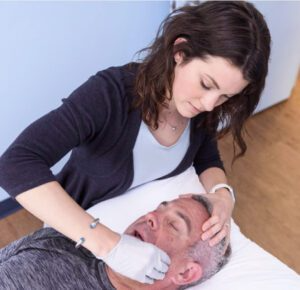How does TMD affect quality of life?
Jaw pain, headaches, pressure in your face, ear pain, muscular tension- no one has time for that!
These symptoms begin to interfere with our ability to concentrate, communicate, and interact with the world around us. Many of us learn to live with these things, but that doesn’t have to be the case! So many TMD patients have lost touch with what it feels like to be relaxed in the jaw/head/neck. Or, what it’s like to not have a constant headache.
While some of these symptoms may require further intervention, there are many things physical therapy can do to significantly reduce the impact these symptoms; especially symptoms that are affecting your day-to-day quality of life.
Outside of reducing the “heaviness” sensation that often accompanies the muscular tension associated with TMD, our goal is to help get you back to your prior level of function with other activities. These activities could include: eating, sleeping, talking, and yawning.
What are simple changes I can make to reduce the impact of TMD on my QOL?
TMD is an all-encompassing diagnosis of dysfunction involving the TMJ in some capacity. While there are different diagnoses or origins of symptoms in this region, the vast majority of TMD patients all have a few common underlying factors. These include: postural abnormalities, poor sleep habits, difficulties with stress management, oral parafunctional habits, as well as other areas of wellness that could stand to be improved such as nutrition, movement, emotional health, etc.
That is not to say you experience any or all of these, but I want to shed some light on the bigger picture of TMD. Many times, the presentation of a TMD patient at an evaluation is a sum of symptoms overtime that have been developing. These symptoms could be developing from a history of some or all of the aforementioned factors. Even if the situation is acute, there may be factors that predisposed you to that acute event occurring in the first place.
The good news is, we have control over many of these factors!
The first step in improving these factors is awareness. At the evaluation process, we breakdown what lifestyle factors you can address to start making the subtle changes that will result in long term success. Some of these simple changes include:
- Adding in meditation to reduce stress levels
- Daily movement for general muscle mobility and stress reduction
- Setting a timer to remind you to unclench your jaw
- Improving your ergonomic set up
- Having a wind-down routine
- Avoid chewing on just one side of your jaw
- Implementing basic postural correction exercises
- Getting a more supportive pillow to sleep on
- Reduce how much tension you’re holding in your shoulders
- Learning the “resting position of the jaw” and maintaining throughout the day
- Reduce chest/shoulder breathing and increase diaphragmatic breathing
- Make sure you’re not looking down or rotated toward at a screen for extended periods of time
The list goes on and there may be more that pertain specifically to YOU!
How does TMD physical therapy improve my QOL?

In physical therapy, we take a comprehensive approach to consider these factors and how they may be influencing your presentation. We address the mechanical and postural factors in treatment with manual therapy, appropriate exercise, and education. We can also help you find the care you need if other practitioners need to be on your team. At Anchor Wellness, many of the team members, including physical therapists and health coaches, are all at one location to address all your needs! In our evaluation, we will take a thorough history to address potential lifestyle factors contributing to your symptoms. We will also educate you on ways to address these factors for long term healing.
Even though TMD may feel complex and overwhelming, you can break it down.
There are many controllable factors that are very manageable. Give yourself a chance to experience relief with less invasive measures and address lifestyle factors that will enhance your overall health and improve your quality of life. Our goal is to help you experience a new norm. A norm that does not involve accepting constant pain and pressure of your head, face and jaw!
About the author:

Dr. Samantha Dove is originally from San Antonio, Texas and has recently moved to Cincinnati from Atlanta, GA with her husband Sam and their dog Koda.
She was a springboard and platform diver for the University of Texas at Austin and has been a Doctor of Physical Therapy for over 5 years. Dr. Dove treats all orthopedic conditions with special interest in the spine, chronic pain, vestibular, and TMJ/TMD populations. She has her Manual Therapy Certification through the University of St. Augustine (USA) and has extensive dry needling training with KinetaCore.
Dr. Dove highly values continuing education in a variety of physical therapy topics but has taken special interest in the CranioFacial courses through USA to advance her TMD treatment skills. Health and wellness are a natural interest of hers in her personal life including participating in activities such as yoga, running, gardening, reading, cooking, family walks at Eden Park and all things self care! She is very excited to explore Cincinnati and to be joining the team at Anchor Wellness Center!


